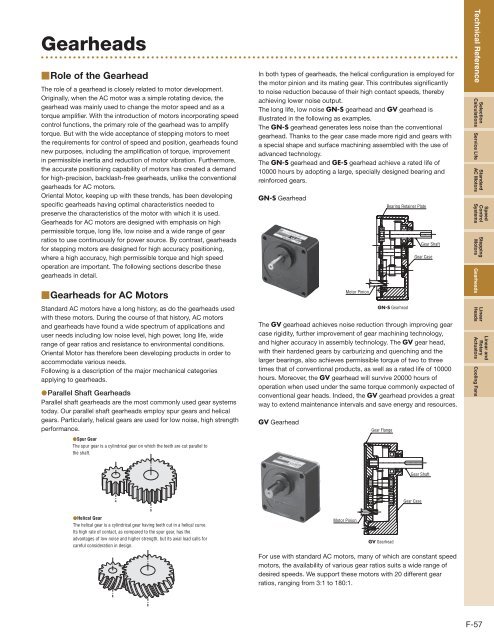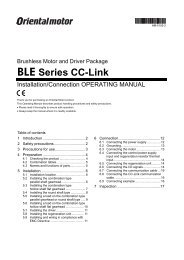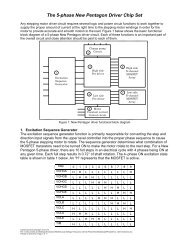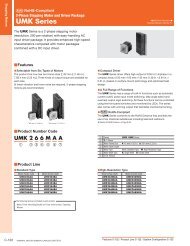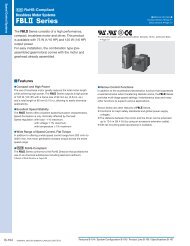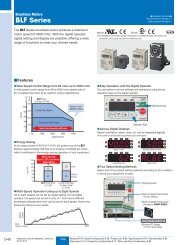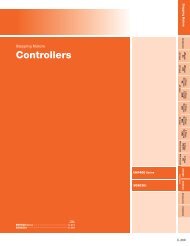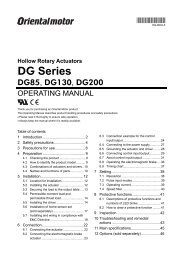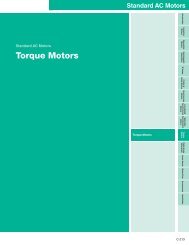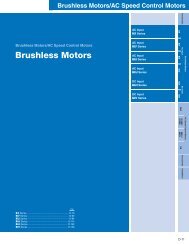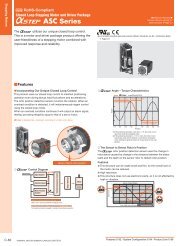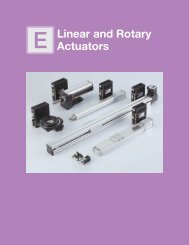Product Reference - Oriental Motor
Product Reference - Oriental Motor
Product Reference - Oriental Motor
You also want an ePaper? Increase the reach of your titles
YUMPU automatically turns print PDFs into web optimized ePapers that Google loves.
Gearheads<br />
■Role of the Gearhead<br />
The role of a gearhead is closely related to motor development.<br />
Originally, when the AC motor was a simple rotating device, the<br />
gearhead was mainly used to change the motor speed and as a<br />
torque amplifier. With the introduction of motors incorporating speed<br />
control functions, the primary role of the gearhead was to amplify<br />
torque. But with the wide acceptance of stepping motors to meet<br />
the requirements for control of speed and position, gearheads found<br />
new purposes, including the amplification of torque, improvement<br />
in permissible inertia and reduction of motor vibration. Furthermore,<br />
the accurate positioning capability of motors has created a demand<br />
for high-precision, backlash-free gearheads, unlike the conventional<br />
gearheads for AC motors.<br />
<strong>Oriental</strong> <strong>Motor</strong>, keeping up with these trends, has been developing<br />
specific gearheads having optimal characteristics needed to<br />
preserve the characteristics of the motor with which it is used.<br />
Gearheads for AC motors are designed with emphasis on high<br />
permissible torque, long life, low noise and a wide range of gear<br />
ratios to use continuously for power source. By contrast, gearheads<br />
for stepping motors are designed for high accuracy positioning,<br />
where a high accuracy, high permissible torque and high speed<br />
operation are important. The following sections describe these<br />
gearheads in detail.<br />
■Gearheads for AC <strong>Motor</strong>s<br />
Standard AC motors have a long history, as do the gearheads used<br />
with these motors. During the course of that history, AC motors<br />
and gearheads have found a wide spectrum of applications and<br />
user needs including low noise level, high power, long life, wide<br />
range of gear ratios and resistance to environmental conditions.<br />
<strong>Oriental</strong> <strong>Motor</strong> has therefore been developing products in order to<br />
accommodate various needs.<br />
Following is a description of the major mechanical categories<br />
applying to gearheads.<br />
●Parallel Shaft Gearheads<br />
Parallel shaft gearheads are the most commonly used gear systems<br />
today. Our parallel shaft gearheads employ spur gears and helical<br />
gears. Particularly, helical gears are used for low noise, high strength<br />
performance.<br />
●Spur Gear<br />
The spur gear is a cylindrical gear on which the teeth are cut parallel to<br />
the shaft.<br />
In both types of gearheads, the helical configuration is employed for<br />
the motor pinion and its mating gear. This contributes significantly<br />
to noise reduction because of their high contact speeds, thereby<br />
achieving lower noise output.<br />
The long life, low noise GN-S gearhead and GV gearhead is<br />
illustrated in the following as examples.<br />
The GN-S gearhead generates less noise than the conventional<br />
gearhead. Thanks to the gear case made more rigid and gears with<br />
a special shape and surface machining assembled with the use of<br />
advanced technology.<br />
The GN-S gearhead and GE-S gearhead achieve a rated life of<br />
10000 hours by adopting a large, specially designed bearing and<br />
reinforced gears.<br />
GN-S Gearhead<br />
<strong>Motor</strong> Pinion<br />
Bearing Retainer Plate<br />
GN-S Gearhead<br />
Gear Shaft<br />
Gear Case<br />
The GV gearhead achieves noise reduction through improving gear<br />
case rigidity, further improvement of gear machining technology,<br />
and higher accuracy in assembly technology. The GV gear head,<br />
with their hardened gears by carburizing and quenching and the<br />
larger bearings, also achieves permissible torque of two to three<br />
times that of conventional products, as well as a rated life of 10000<br />
hours. Moreover, the GV gearhead will survive 20000 hours of<br />
operation when used under the same torque commonly expected of<br />
conventional gear heads. Indeed, the GV gearhead provides a great<br />
way to extend maintenance intervals and save energy and resources.<br />
GV Gearhead<br />
Gear Flange<br />
Technical <strong>Reference</strong><br />
Selection<br />
Calculations Service Life<br />
Standard<br />
AC <strong>Motor</strong>s<br />
Speed<br />
Control<br />
Systems<br />
Stepping<br />
<strong>Motor</strong>s Gearheads<br />
Linear<br />
Heads<br />
Linear and<br />
Rotary<br />
Actuators Cooling Fans<br />
Gear Shaft<br />
Gear Case<br />
●Helical Gear<br />
The helical gear is a cylindrical gear having teeth cut in a helical curve.<br />
Its high rate of contact, as compared to the spur gear, has the<br />
advantages of low noise and higher strength, but its axial load calls for<br />
careful consideration in design.<br />
<strong>Motor</strong> Pinion<br />
GV Gearhead<br />
For use with standard AC motors, many of which are constant speed<br />
motors, the availability of various gear ratios suits a wide range of<br />
desired speeds. We support these motors with 20 different gear<br />
ratios, ranging from 3:1 to 180:1.<br />
F-57


